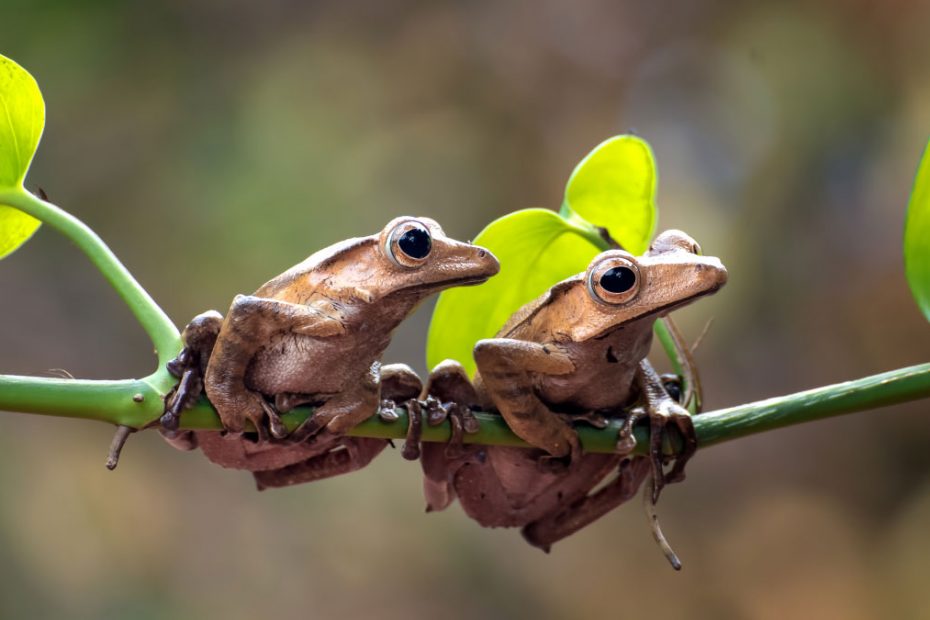The Borneo Eared Frog (Polypedates otilophus) is a unique frog species found in the rainforest ecosystems of Borneo. These frogs are known for their distinctive appearance and large size. Their unique features made them a fascinating subject for animal enthusiasts, students, and researchers alike.
So, how is their physical appearance interesting? As their name suggests, these frogs have prominent external eardrums, known as “tympana.” These are larger than those found in most other frog species. Their distinctive appearance also includes large eyes, a broad head, and a body that can grow up to 10 cm long.
They are essential species to study and conserve due to their crucial role in the rainforest ecosystem. As a food source for various predators and a predator itself, it helps maintain the balance and health of the ecosystem.
The Borno-Eared Fron’s physical traits and habitat will be discussed in this essay. Also, we will be informed of how the Borneo Eared Frog behaves and its conservation status. So continue reading!
Species Name and Classification
Species name: Polypedates otilophus
Common name: Borneo Eared Frog
Class: Amphibia
Family: Rhacophoridae
Genus: Polypedates
Species: P. otilophus
Borneo Eared Frog Physical Characteristics

The Borneo Eared Frog is one of the largest Borneo Eared frog species in Borneo, measuring up to 9 cm in length and weighing up to 30 grams. Their skin is typically green or brown with darker markings. They have large eardrums visible on the sides of their heads, which gives them their name.
Their skin is covered in small, warty bumps that provide camouflage and protection from predators.
Overview of Frog Species in Borneo

Borneo is home to a diverse range of frog species, including the Borneo Eared Frog. Over 180 species of frogs are found in Borneo, with more being discovered every year. Other frog species found in Borneo include
- The Long-Nosed Horned Frog
- Bornean Tree Hoke Frog
- Bornean Flat-headed Frog
Adaptations for Rainforest Habitat
The Borneo Eared Frog has developed unique adaptations to survive in their rainforest habitat.
- Their specialized skin helps them retain moisture in a humid environment. The warty bumps on their skin provide camouflage and protection from predators.
- Their vocalizations are crucial for communication and finding mates. Additionally, they have developed unique calls to distinguish themselves from other frog species in their habitat.
Exploring the Rainforest Habitat of Borneo-Eared Frogs
You can better comprehend Borneo eared frog habitat by understanding their environment and behavior. We shall be aware of the rainforest’s geographical distribution, preferred habitat, and ecosystems. In addition, the elevation range will be addressed.
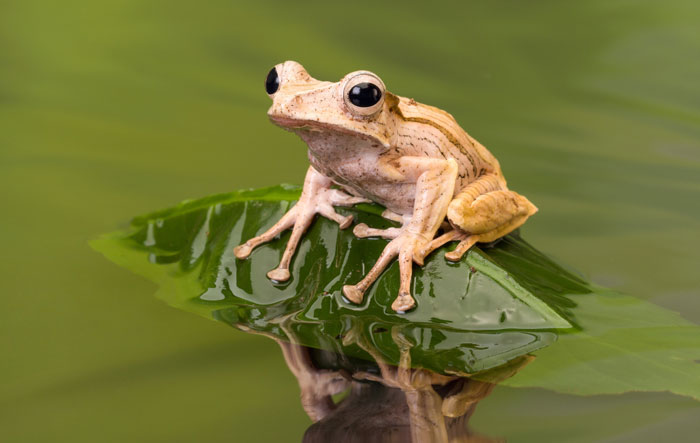
Rainforest Ecosystems
Tropical regions are home to thick, diversified landscapes known as rainforest ecosystems. Large rainforests can be found on the Southeast Asian island of Borneo. Borneo-eared frogs are a species of frog that can be found in the rainforests of Borneo.
The Borneo rainforest ecosystem is characterized by things which provide an ideal environment for various plant and animal species. That’s why it requires
- Dense vegetation
- High humidity
- High rainfall
The Borneo rainforest ecosystem consists of various forest types, including
- Lowland dipterocarp forests
- Peat swamp forests
- Montane forests
These forest types offer the Borneo-eared frog excellent breeding sites. It may usually be found along rivers and streams in these types of forests.
Preferred Environment
The Borneo-eared frog prefers to live near rivers and streams within the rainforest ecosystem. This is likely due to the availability of water sources, which are important for breeding, laying eggs, and finding food.

However, the frog’s diet consists mainly of insects and other small invertebrates that are found near water sources. So, the rainforest’s humid and warm climate is also suitable for the frog’s specialized skin, which helps it retain moisture.
Geographic Distribution
The Borneo-eared frog is only found on the island of Borneo, which is located in Southeast Asia. The island is divided into three countries: Indonesia, Malaysia, and Brunei. The frog is native to the rainforest regions of Borneo, which are known for their high biodiversity.
Elevation range
Borneo-eared frogs can be found at various elevations within the rainforest ecosystem. They are typically found in lowland rainforests but have also been spotted in upland forests at elevations of up to 3,600 meters above sea level.
This indicates that the frog is adaptable to a range of environmental conditions within the rainforest.
Borneo Eared Frog During Breeding: Behavior Analysis
They are unique frogs that exhibit a variety of interesting behaviors. These are including nocturnal activity, vocalizations during the breeding season, and adaptations for survival in their environment.
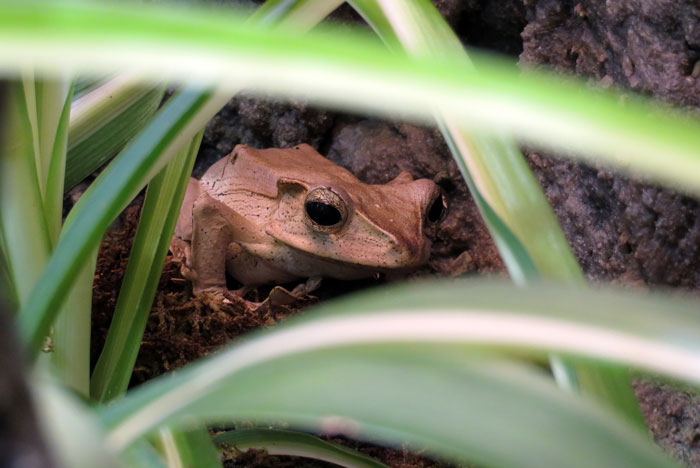
Here’s a closer look at the different behaviors exhibited by these frogs:
Activity Patterns
Borneo Eared Frogs are nocturnal creatures, which means that they are most active at night. During the day, they typically hide in the vegetation, either on the ground or in the trees.
Locomotion
These frogs are skilled climbers and use their long, powerful legs to hop from branch to branch in the trees. They are also good swimmers and can move through the water with ease.
It’s important to note that the description of the legs and spines splitting the air is likely an exaggeration, as Borneo-Eared Frogs do not fly.
Social Structure And Communication
Borneo Eared Frogs are primarily solitary creatures, although they may come together during the breeding season to mate.
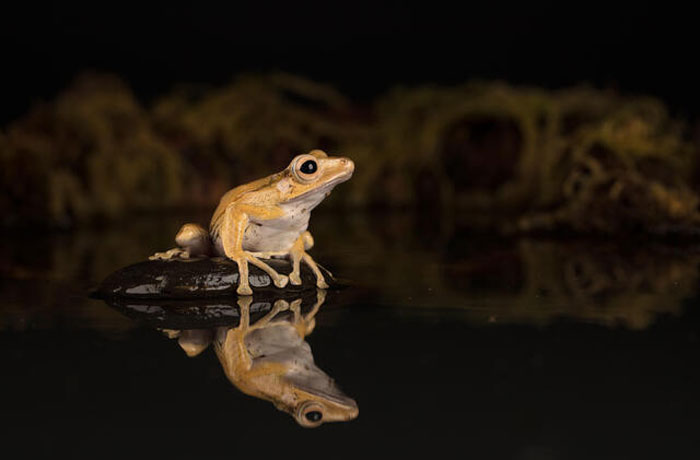
These frogs use vocalizations to communicate with one another, particularly during the breeding season. Males produce a series of loud, repetitive calls to attract females and establish territory.
Predators and Defense Mechanisms
Borneo Eared Frogs face a variety of predators in their environment, including snakes, birds, and small mammals.
To defend themselves, they have developed several adaptations, including their specialized skin and their ability to blend in with their surroundings.
Mating Season in a Nutshell
There is no exact information about the mating season of Borneo-eared frogs. But it is assumed that mating generally occurs in the rainy season in Borneo.
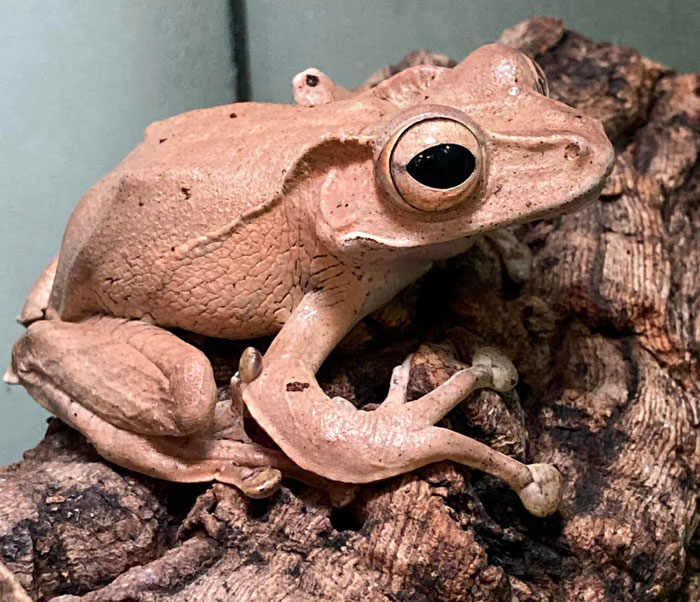
Let’s discuss their mating rituals, fertilization type, egg-laying habits and the egg development process.
Mating Rituals
- During the breeding season, males will often call out to attract females using a series of high-pitched vocalizations.
- Once a female has been located, the male will approach her and begin a courtship display.
- If the female is receptive, she will allow the male to climb onto her back. This behavior is known as amplexus.
- During amplexus, the male will fertilize the eggs as the female lays them.
- After the eggs are fertilized, the male’s role in the breeding is complete.
- The female will remain with the eggs, guarding them against predators.
Fertilization Type

- External fertilization has been a successful reproductive strategy for Borneo-eared frogs.
- As the female lays eggs, the male releases sperm over the eggs to fertilize them.
- The fertilized eggs are typically deposited in ponds, streams, or other frog habitats.
- They develop into tadpoles there.
Egg-laying Habits
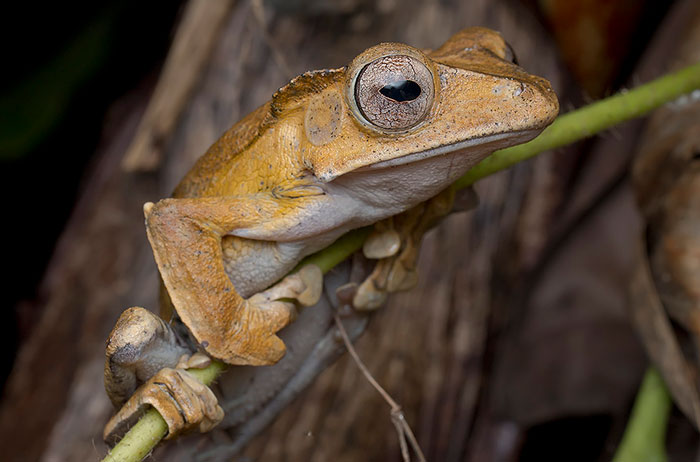
- Borneo-eared frogs of the majority of species deposit their eggs in water, usually in ponds or still streams.
- The females lay the eggs in clusters or small masses and attach them to vegetation.
- Some species lay their eggs on vegetation above the water surface, such as in tree holes or bamboo internodes.
- Some Borneo-eared frog species lay their eggs in fast-moving water, while others lay them on the underside of leaves. They do this to protect their eggs from predators on the ground.
Egg Development stages
We will discuss the egg development process in three segments. The egg stage, tadpole stage and metamorphosis phase.
- Egg Stage: Either on plants above water or in water, the female lays her eggs. Tadpoles, which are aquatic and have gills for breathing, are produced when the eggs hatch. Algae and other aquatic plants are the main sources of food for tadpoles.
- Tadpole Stage: The tadpoles undergo a series of changes. This is including the development of legs, the absorption of their tails, and the development of lungs for air breathing.
- Metamorphosis Stage: The tadpoles complete their transformation into adult frogs. They develop fully functioning lungs, absorb their tails, and grow into their adult form.
Beyond the initial egg-laying stage, Borneo-eared frogs do not show parental care.
Borneo Eared Frog’s Simple Dietary
The Borneo Eared Frog’s diet isn’t too unique compared to the other frog species. And the primary food sources of Borneo-eared frogs vary depending on the species and their stage of development.
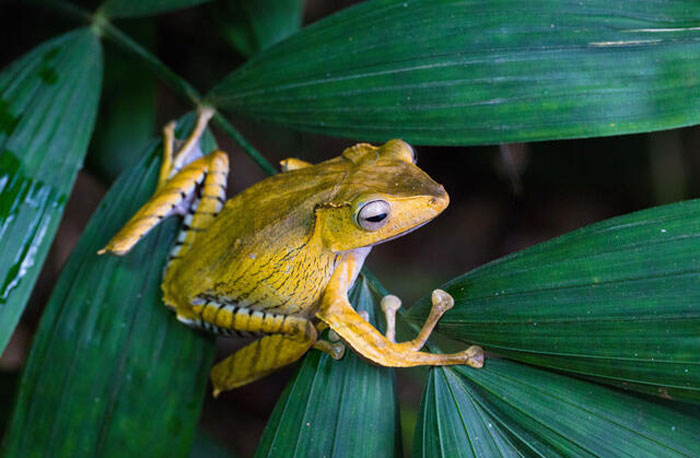
- They eat mostly algae and other aquatic plants in the water bodies, where they develop as tadpoles.
- Invertebrates of various sizes, including insects, spiders, and other small arthropods, become a larger part of their diet as they get older.
Apart from that, the Borneo-eared frogs are known to exhibit opportunistic feeding habits. Also, according to their surroundings and developmental stage, they are adaptive and consume any accessible prey.
Conservation Status
When discussing frog conservation status, you may ask what the species’ IUCN status is. Along with this, other additional things need to be discussed too. Let’s get into those.
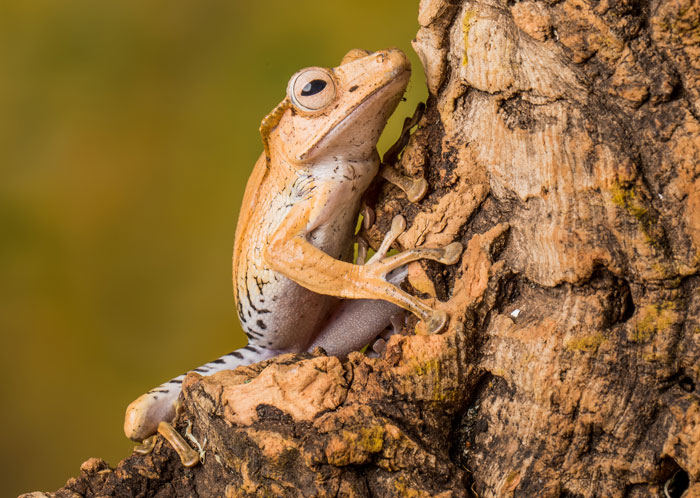
IUCN Status
The Borneo Eared Frog is listed as “Least Concern” on the IUCN Red List of Threatened Species, meaning that it is not currently facing an imminent risk of extinction. However, this does not mean that the species is not facing threats to its survival.
Threats
One of the primary threats to Borneo-Eared Frogs is habitat loss due to deforestation. The rainforest ecosystems of Borneo, where these frogs are found, have been subject to extensive logging and conversion to agriculture. And it has resulted in the fragmentation and loss of critical habitat.
Additionally, pollution and climate change can also impact the availability of suitable breeding sites and food sources for these frogs.
Efforts to Protect Borno-Eared Frog
Efforts are being made to protect Borneo-Eared Frog populations, including habitat preservation programs by research institutions and various conservation organizations.
Legal protections have been put in place in some areas to restrict logging and preserve critical habitat. Captive breeding programs have also been established to increase the number of frogs in captivity. So they can be reintroduced into the wild.

Habitat restoration projects are also important for the long-term survival of Borneo Eared Frogs. These programs involve the replanting of native vegetation and the restoration of degraded habitats. This is to provide suitable breeding sites and foraging areas for the frogs.
Continuous Conservation Efforts are Essential
Continued conservation efforts are crucial for the survival of Borneo-Eared Frogs and the rainforest ecosystems they inhabit. The loss of this species would not only represent a loss of biodiversity but could also have ecological consequences for the entire frog ecology.
Borneo Eared Frogs play an important role in maintaining the balance of their ecosystem as both predator-prey interactions. And their loss could have a cascading effect on other species within the ecosystem.
Interesting Facts About Borneo Eared Frogs

- Borneo Eared Frogs have adapted to have suction cup-like toe pads, allowing them to climb and cling to vertical surfaces such as tree trunks and leaves.
- The skin of Borneo Eared Frogs contains bioactive compounds that have potential medical applications.
Conclusion
To summarize, the Borneo Eared Frog is a captivating amphibian species found in Borneo’s rainforest ecosystems. With distinctive physical features and behaviors, they serve a vital role in maintaining the ecosystem’s health and balance.
Their unique adaptations to survive in their habitat highlight the importance of Borneo Eared frog conservation. Therefore, we must continue researching and conserving the Borneo-Eared Frog and its habitat to ensure the preservation of the rainforest ecosystem.
For those interested in learning more about these fascinating creatures, further reading is recommended. It will enhance the significance of Borneo eared frog conservation efforts too.

Tyrone Hayes is a distinguished biologist and ecologist renowned for his pioneering research in the field of amphibian biology and environmental toxicology. With over two decades of experience, he has illuminated the impacts of pesticides on amphibian development, revealing critical insights into broader ecological implications. Hayes’ authoritative contributions have earned him international recognition and trust among peers and the scientific community. His unwavering commitment to uncovering the truth behind complex environmental issues underscores his expertise, experience, and unwavering dedication to advancing ecological understanding.
